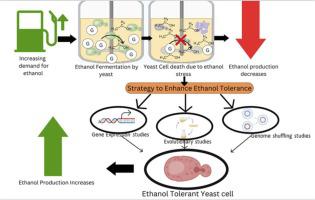Process Biochemistry ( IF 3.7 ) Pub Date : 2024-01-03 , DOI: 10.1016/j.procbio.2023.12.024 Gandasi Ravikumar Sahana , Balamuralikrishnan Balasubramanian , Kadanthottu Sebastian Joseph , Manikantan Pappuswamy , Wen-Chao Liu , Arun Meyyazhagan , Hesam Kamyab , Shreeshivadasan Chelliapan , Biljo V. Joseph

|
Saccharomyces cerevisiae is one of the prominent strains in the brewing and bioethanol industries and has been used for many industrial purposes for ages. Though the organism is an outstanding ethanol producer, the major limiting factor is the stress the organism undergoes during fermentation. One of the significant stresses is the ethanol stress, created by ethanol accumulation in the medium. The ethanol starts to interact with the yeast cell membrane; further, as ethanol concentration increases, it affects a lot of cell organelles. Thereby, cellular activities get disrupted, causing cell death and hence reducing ethanol production. The organism has developed many strategies to overcome this stress by activating the stress response pathway, which regulates many genes involved in modifying the cell membrane cell wall, renaturation of proteins, and altering the metabolism. However, with higher ethanol concentrations, the yeast cells will be unable to tolerate, leading to cell death. Hence, to minimize cell death at higher ethanol concentrations, there is a need to understand the effect of ethanol and its response by the organism; this helps improve the ethanol tolerance of the organism and, thereby, ethanol production. Although many research works are carried out to understand the vital aspect of the tolerance and are reported, very few review papers cover all these points. Hence, this review is designed to include information on all the elements of ethanol tolerance, i.e., ethanol tolerance of different strains of S. cerevisiae, the effect of ethanol on the yeast cells, the mechanism used to tolerate the ethanol, and various techniques developed to improve the ethanol tolerance of the yeast cells.
中文翻译:

酵母乙醇耐受机制综述:生物技术应用的当前知识和未来方向
酿酒酵母是酿造和生物乙醇工业中的重要菌株之一,多年来一直用于许多工业用途。尽管该生物体是出色的乙醇生产者,但主要的限制因素是该生物体在发酵过程中承受的压力。重要的胁迫之一是乙醇胁迫,由培养基中乙醇积累产生。乙醇开始与酵母细胞膜相互作用;此外,随着乙醇浓度的增加,它会影响许多细胞器。因此,细胞活动被破坏,导致细胞死亡,从而减少乙醇产量。生物体已经开发出许多策略来通过激活应激反应途径来克服这种应激,该途径调节许多涉及细胞膜细胞壁修饰、蛋白质复性和改变代谢的基因。然而,随着乙醇浓度升高,酵母细胞将无法耐受,导致细胞死亡。因此,为了最大限度地减少较高乙醇浓度下的细胞死亡,需要了解乙醇的影响及其生物体的反应;这有助于提高生物体的乙醇耐受性,从而提高乙醇产量。尽管许多研究工作都是为了了解耐受性的重要方面并进行了报道,但很少有综述论文涵盖所有这些要点。因此,本综述旨在包括有关乙醇耐受性的所有要素的信息,即不同酿酒酵母菌株的乙醇耐受性、乙醇对酵母细胞的影响、耐受乙醇的机制以及开发的各种技术提高酵母细胞的乙醇耐受性。











































 京公网安备 11010802027423号
京公网安备 11010802027423号